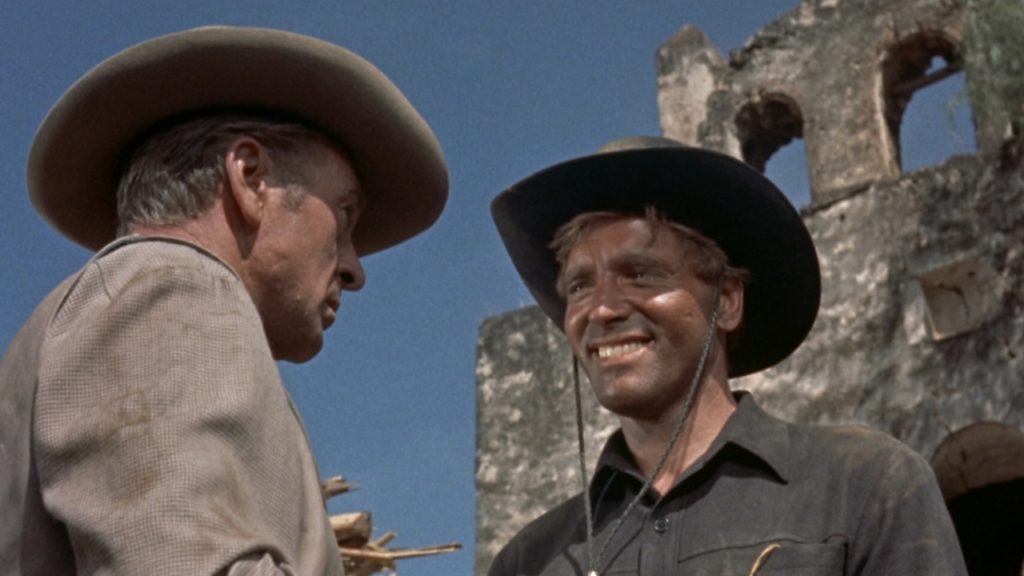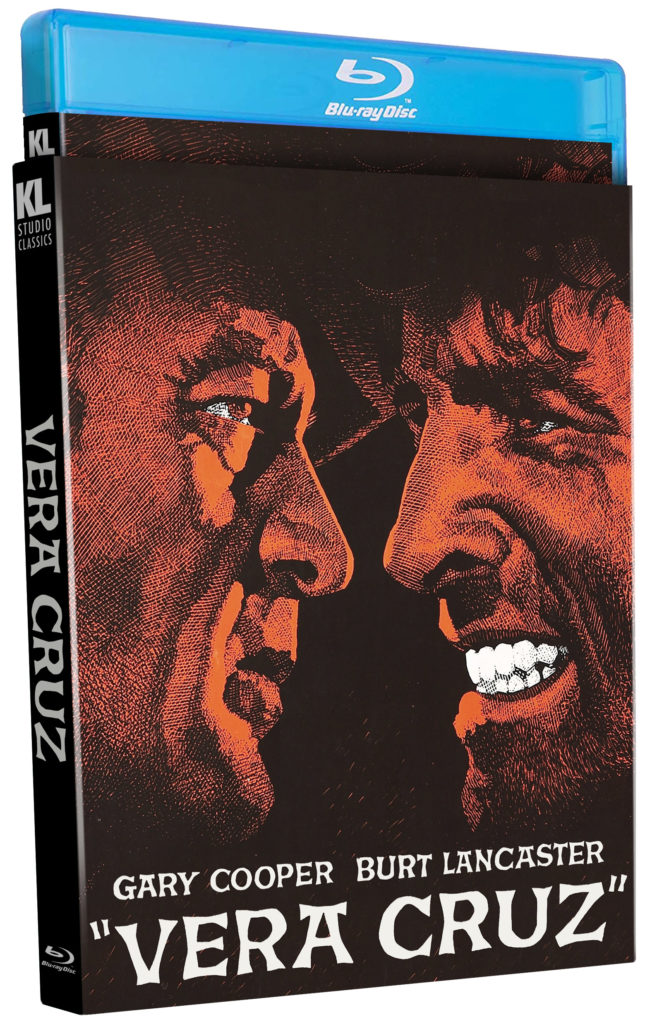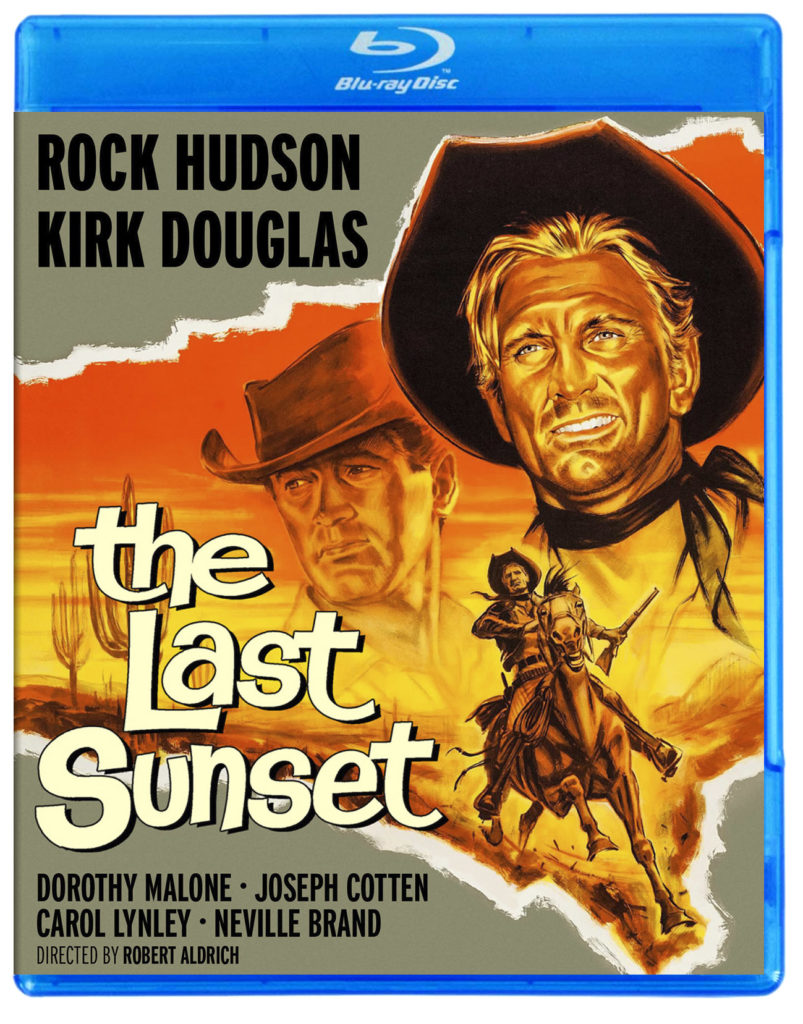Allegro Bob Aldrich Offers Up Black-clad Pair Of South-of-the-border, Western SOBs, New On Blu-ray!
STREET DATE: October 12th, 2021/KINO LORBER STUDIO CLASSICS
Classic Hollywood’s uniquely positioned “independent insider” Robert Aldrich screen-traverses cañón, arroyo, and llanuras in a stark pair of South-of-the-border Westerns, new on Blu-ray from Kino Lorber Studio Classics.
While the Mexican Odyssey was nothing new to Hollywood or international cinema – Vera Cruz KL commentator Alex Cox reminds listeners that, way back in 1910, American film company Mutual Films contracted world-exclusively with Mexican insurrectionist Pancho Villa himself to camera-document his revolutionary military campaign as it was happening – Robert Aldrich’s mid-century Mexican Westerns not only reinforced the director’s admiring French critic-gifted name of “Les Gros Bob”, but also proved tonally, stylistically, and even narratively inescapable for subsequent Sou’-by-Sou’-Westerns, especially those later made by Sam Peckinpah and Sergio Leone. American desperadoes crossing the Rio Grande to pursue fortune-and-glory at-all-costs, up-to-and-including death? Regarding the latter, the myth-level iconography of a black hat fatally sweeping the desert sand strongly supports the visual proof that Robert Aldrich artistically preceded their later echoing portrayal by a solid decade.
Not that that much matters. But what does matter, particularly regarding those subsequent filmic echoes, is how director Aldrich also anticipates a view of character, coming out of previous Westerns, that is here repositioned, in terms of story and setting, towards a marked ambivalence that would come to dominate the majority of Westerns made thereafter. Revisionism as a major Western theme was just beginning to take hold in the early-to-mid 1950’s, such as in the darker, psychological Westerns of director Anthony Mann and actor James Stewart — where the former presented the latter in a heroic yet tarnished screen image — but Aldrich’s subsequent, contrasting character studies, made and set outside the narrow, liminal reach of literal and figurative American sovereignty, had by comparison the artistic balls to bait-and-switch cinematic heroism for outright villainy.
As played, one might add, by two of the great matinee idols of the era, Burt Lancaster and Kirk Douglas, respectively. Both here possessed of two of the most frightening grins in movie history, Lancaster’s in particular more akin to a predator bearing his incisors than a facial expression remotely friendly, both also possessed, as producer-stars, a degree of financial and artistic power on these foreign-soil location shoots that made these portrayals possible in the first place. Vera Cruz produced with the Hecht-Hill-Lancaster imprimatur, the last-named actor’s company with production partners Harold Hecht and James Hill, and The Last Sunset under the aegis of BrynaProd. S.A., Kirk Douglas’s own company (named for his mother), Robert Aldrich obviously had more than location-shooting to contend with — considering the outsize egos of his macho stars — but, despite or perhaps because of those difficulties, Mexican scenery and conflict-driven plots add immeasurably to both films’ compelling anti-veneration of black-clad, South-of-the-border, Western SOBs.
To put it briefly, and to cut to the chase as it were, KL offers a great opportunity this October to revisit the screen birth(s) here of the modern anti-hero.

VERA CRUZ
DIRECTED BY ROBERT ALDRICH/1954

“Why, you dirty son of a…” Lancaster as black hat-to-boot-wearing, wild bunch leader Joe Erin’s mid-film refrain to former Confederate officer and war-impoverished plantation owner Gary Cooper as Ben Trane — both trying to charm a Countess (Denise Durcell), fool a Marquis (Cesar Romero), and impress an Emperor (George Macready) in the open-air dancing-court of an oceanside palace — carries the true import of the double-, triple-, and even quadruple-crossing gold-transport mission to the title location soon to follow. The place is Mexico, the time is shortly after the American Civil War, and the players include north-of-the-border bandits and ex-military fortune-seekers, homegrown thieves and peasant revolutionaries, self-styled political aristocrats and displaced European royalty; but all are, in the end, united by varying degrees of homicidal, suicidal, and genocidal bastardry born of the peculiarly and humanly inhuman lust for power and money.
For reasons at least initially obscure to both, a pair of dry and dusty horsemen become entangled in each other’s respective destiny after emerging from the desert, south of the Rio Grande, pursued by the Mexican army. The first, Ben Trane (Cooper), is lean, weathered, aged before his time; the second, Joe Erin, has the devil’s grin, a jumpy trigger-finger, and the pleasant manner of a rattlesnake. Trane wily rebuffing Erin’s predatory advances, stealing Erin’s horse and riding off to town, the latter gang leader quickly recognizes a fellow desperado beneath the former’s gentlemanly facade. After a spectacular public demonstration of blithe ruthlessness, where Erin shoots two of his own men with a dancer’s turn and revolver-spin behind his own back, both are soon recruited by the commander, and self-styled Marquis (Romero), of the very armed forces they were recently fleeing in order to accompany his royalist army to the newly-established palace of the Emperor Maximilian (Macreeady).
That “authority” named above is immediately challenged in the very next visual passage of the Juarista revolutionaries, led by General Ramírez (Morris Ankrum), who suddenly appear white-shirted, sombrero-wearing, and rifle-strapped at all visual points of reference — from behind the walls of the courtyard, on top of the corazón-arched gates, and over the stone roofs lining the sand-blasted desert city — surrounding and cutting off Trane, Erin and his gang, the faux-Marquis, and the Mexican army. Luckily for the latter, however, Erin is a bigger SOB than all of them put together, and, spotting a pair of playing children, motions a couple of his underlings standing nearby (Charles Bronson, Jack Elam) towards a potentially sickening move in order to remove this stalemate…
Playing with the utter ruthlessness mentioned above for all its 94 minutes of compounding betrayals, murderous gambits, and utter disregard of human decency — if such a thing exists in this world — Vera Cruz retains a take-no-prisoners aesthetic with the dark consistency of its literal and figurative black hole of a smiling-to-hell antagonist. Performed with full go-for-the-throat gusto by Lancaster, the film-length suspense held by Cooper’s only-by-comparison “good” Trance, and by extension the audience, over whether there is any redeeming qualities whatsoever to Wild Bunch-leader Joe Erin’s precision sharp-shooting, daring horse-galloping, and balcony-leaping gymnastics — past too numerous-to-count Mexican stand-offs, shootouts, and sieges — is only answered in the end by whether Erin’s admirable bravery and undeniable skill can ultimately overcome his utter bastardry. ::SPOILER:: It can’t.

THE LAST SUNSET
DIRECTED BY ROBERT ALDRICH/1961

“Look, Belle! It’s St. Elmo’s Fire…” Black-favoring outlaw gunman, now reluctant cowboy, Brendan O’Malley (Kirk Douglas), with his sun-bleached hair and sun-reflective teeth providing a striking visual contrast by daylight to his darker sartorial choices, leads the recently widowed Mrs. Breckenridge (Dorothy Malone) — whom O’Malley had left sixteen years before as a mere slip of a girl named “Belle” — mid-film up a nighttime butte promontory overlooking the canyon below to view the blue-rippling atmospheric phenomenon glittering its “fallen stardust” on the glowing sea of night-grazing cattle stretching 1500 miles north to the now-darkened horizon of the Rio Grande and the U.S.-Mexican border.
Somewhere nearby, perhaps, as Belle softly but defiantly rejects O’Malley for a St. Elmo’s-like “storm” raging within him, lawman Dana Stribling (Rock Hudson) — presently foreman of this cattle drive — calmly considers in the sustaining heat of the crackling campfire, with increasing nighttime reluctance against the flickering, reflective flame, how best to subdue, capture, or kill the dangerous but charming wanted man when they reach the United States. Also nearby, sleeping soundly in Mrs. Breckenridge’s hitched wagon, Missy Breckenridge (Carol Lynley), Belle’s 16-year-old daughter, reaches out with night-visions of her own to the handsome and humorous yet dark and mysterious stranger O’Malley, who has recently entered not only her life and waking thoughts, but also her dreams.
Visually apparent throughout the opening credits sequence, with Ernest Gold’s rumbling score accompanying scenic views of the beautiful if inhospitable Mexican terrain, is the parallel pathways of two horsemen riding roughshod through the desert, over steep canyons, and into a piss-poor village. The darker horse-figure, awarded the first close-up, grins gleefully at some gruesome cockfighting carnage on the edge of the pueblo, while the greyer, more resolute rider follows doggedly behind in unmistakable pursuit. Before that inevitable confrontation takes place — a pair of pearl-handled pistols a-glinting in checked stalemate to a cunningly sash-concealed derringer — the first figure in town, whom we soon know as the one-and-only O’Malley (Douglas), makes the object of his destination clear as he approaches the nearby Breckenridge ranch; where the lady of the house, Belle (Malone), acknowledges O’Malley’s long absence from her life warily, while Belle’s daughter Melissa (Lynley) greets the romantic figure’s entrance to her own life as quickly, warmly, and charmingly as O’Malley soon renames the open-hearted young lady “Missy”.
Belle’s aging and alcoholic husband John Breckenridge (Joseph Cotten), a crippled Confederate veteran, initially absent on the ranch as he is also seemingly ineffectual in character, somehow recruits both O’Malley and his pursuer Dana Stribling (Hudson), equally smitten by Belle, to lead the Breckenridge herd 3,000 miles north to the Rio Grande and South Texas; Stribling, bound also by duty and revenge, reasons this as the best way to keep hold of the slippery and snake-like O’Malley. The possible harsh conditions of the approaching trail are nothing, however, to the passions and emotional entanglements that will assail each of these characters as they individually (and personally) pursue the(ir) North Star.
Title-telegraphed with the sad yet poetic inevitability of Western genre expeditions of yore, screenwriter Dalton Trumbo emerges with his third credit from behind the Hollywood blacklist to imbue the three- and even four-angled romance on this overheated Mexican cattle trail — and not only from the far southern sun beating harshly down on the desert sand passing under the driven herd — with a hothouse passion equal to and at times exceeding co-stars Hudson and Malone’s previous Douglas Sirk melodrama Written on the Wind (1956). As with Vera Cruz, ultimately, the old black hat Western trope of the good-bad man plays film-length havoc with the audience’s expectations and sympathies to the point where, despite one’s immediate suspicions — again telegraphed, this time stylistically, through framing, character-blocking, and the general je ne se quais of Allegro Bob’s mise en scène — that this funny, poetic, charming yet sinister, conniving, and (demonstrably) murderous outlaw will or not not, justly or unjustly, receive his fatal comeuppance at The Last Sunset. ::SPOILER:: He does.
…
What seemed at the outset a “clever” approach for writing a dual review of complementing pair of Robert Aldrich’s mid-century Westerns has unfortunately left little in the way of closer analysis, deeper discussion, or informed interpretation of the development of the Western genre, the additional history and context of their Mexican setting, and, more specifically, to the filmmaking fingerprints and subsequent influence of director Robert Aldrich. Blinded as the reviewer was by the combined star-wattage of their respective producer-stars’ brilliant grins — marvelling how actors in or approaching their own mid-life, Burt (1954) around 40 and Kirk (1962) around 45, could appear so physically, and especially dentally, vital — one regrets having here given little space to rigorous David Bordwell-style neoformalist examination of the poetics of cinema, or tortured Howard Bloom-like critical investigation of the anxiety of directorial-by-way-of-authorial influence; but hopefully a few morning coffee-fueled wisecracks about vain actors playing then atypical, soon proto-typical good-bad guys so effectively will justify my (very appreciated) reviewer’s copies.
(As a further skippable parenthetical, being personally smack-dab between the ages of Lancaster and Douglas listed above — albeit with far more facial wrinkles and far less cranial hair, muscle mass, and gum tissue — I must also admit a stronger, additional sympathy for two middle-aged guys so comfortably playing to-varying-degrees unrepentant SOBs.)

Fortunately, one’s ever-reliable review-ending transition, Kino Lorber has director, actor, and author Alex Cox and writer and critic Nick Pinkerton in respectively fine and deep, authoritatively-lulling voices to films-length comment on both Vera Cruz and The Last Sunset. Alex Cox brings appreciation and analysis in equal measure to his eloquent discussion of Vera Cruz and Mexican-set Westerns, their influence on later revisionist and Spaghetti Westerns, and how this film and its director, Robert Aldrich, provided an inescapable, even unconscious template for stories, sequences, stylistics, and characters in later films like A Fistful of Dollars (1964) and (especially) The Wild Bunch (1969). Nick Pinkerton (unsurprisingly) digs deep into the sun-scorched geographical and emotional terrain of The Last Sunset, bridging contemporary press notices, write-ups, and reviews alongside later, sustained critical analyses — quoting at length from the acclaimed and now hard-to-find 1995 James Ursini and Alain Silver biography of Robert Aldrich — in explicating the artistic intent, production difficulties, and thematically disquieting tangents of this perennial Mexican-Western film maudit.
(In comparison, it’s interesting to note how entirely opposing Cox’s and Pinkerton’s approach to the material is — Cox at one point claims a lifelong aversion to film semiotics, for one, upon which much of Pinkerton’s analysis seemingly, or at least by proxy, depends — but how closely both come in overlapping discussions to viewing both the director’s style and characteristics while also bringing a similar mind’s eye on the films’ visual and thematic points of interest.)
A Trailers From Hell spot by John “Three Amigos!” Landis complements Kino Lorber’s usually (and corporately relevant) assortment of film trailers included on the Vera Cruz disc, with Landis’s usually charming, offhand schtick pointing out IT’S THE WILD BUNCH BEFORE WILD BUNCH! at the trailer’s every hyperbolic turn-of-narrational-and-visual phrase.
Finally (even Burt’s and Kirk’s grins groaning under the weight of words above), KL provides a reliably clean transfer and visible improvement — particularly during Aldrich cinematographer’s Ernest Laszlo’s photo-sensitive day-for-night sequences — on visual film elements from previous DVD releases, especially Vera Cruz’s difficult 2:1 aspect ratio, which had noticeably suffered on earlier DVD releases. (Had The Last Sunset ever appeared before on home video, or at least DVD? Dunno, but it sure looks terrific on Blu-ray.)
Well then, our good day’s done/under the hot Mexican sun, it leaves one with no further recourse than to sign off at a point past cunning, charm, bravery, and mortality with a farflung and hoarse-throated, Burt-and-Kirk-inflected HA!
We’ll catch up, and settle up, on up near the border.
Film images used, culled from scant internet offerings, are credited to DVDBeaver, Mubi, and IMDB; excepting the final photo, which is credited to and taken by my own poor self. The film images are used only as a visual reference and are not reflective of the visual quality of Kino Lorber’s Blu-rays; while the final, sadly, is entirely visually reflective of my own poor mug.

